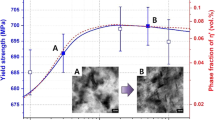Abstract
Both differential scanning calorimetry (DSC) and hot stage transmission electron microscopy were used to characterize the solid state reactions accompanying heating of the highest strength (T651) and overaged (T7351) tempers of 7075 aluminum alloy. Each of the observed endothermic or exothermic reactions that occurs over the 20 to 500°C temperature range has been ascribed to the dissolution or formation of a specific precipitate. The dissolution of each matrix phase,i.e., GP zones, ή and ή, can be characterized by a distinguishable dissolution temperature, dissolution enthalpy, activation energy, and activation entropy. The values of activation energy and activation entropy for the dissolution of the initial matrix precipitate of these phases indicate that the relative stability of the matrix precipitates is primarily influenced by the entropy rather than the energy term. This investigation provides a basis for the use of DSC analysis in the rapid, quantitative identification of the matrix microstructure of 7075 aluminum alloy as well as in the characterization of the matrix microstructure of other 7000 series aluminum alloys.
Similar content being viewed by others
References
L. F. Mondolfo:MetalsMater., 1971, vol. 5, pp. 95–124.
G. Thomas and J. Nutting:J. Inst. Metals, 1959-60, vol. 88, p. 81.
A. Kelly and R. B. Nicholson:Progr. Mater. Sci., 1963, vol. 10, p. 216.
L. F. Mondolfo, N. A. Gjostein, and D. W. Levinson:Tram. AIME, 1956, vol. 206, p. 1378.
J. Gjonnes and C. J. Simensen:Acta Met., 1970. vol. 18. p. 881–90.
K. Asano and K. Hirano:Trans. Jap. Inst. Metals, 1968, vol. 9, pp. 24–34.
D. S. Thompson: inThermal Analysis, R. F. Schwenker, Jr. and P. D. Garn, eds., vol. 2, p. 1147, Academic Press, New York, N. Y., 1969.
P. Adler, G. Geschwind, and R. Delasi:Proc. of Third International Con-ference on Thermal Analysis, 1972, vol. 2, pp. 747–57, Berkhauser Verlag, Basel, Switzerland.
P. N. Adler, R. Delasi, and G. Geschwind:Met. Trans., 1972, vol. 3, pp. 3191–200.
R. A. Baxter: inThermal Analysis, R. F. Schwenker, Jr. and P. D. Garn, eds., vol. l,p. 65, Academic Press, New York,N.Y., 1969.
D. O. Sprowls and R. H. Brown:International Conference on Fundamental Aspects of Stress Corrosion Cracking, 1969, p. 466, NACE, Houston, Texas.
R. Swalin:Thermodynamics of Solids, J. Wiley and Sons, Inc., New York, N.Y., 1963.
R. A. Frost and R. G. Pearson:Kinetics and Mechanisms, p. 98, J. Wiley and Sons, Inc., New York, N.Y., 1953.
Author information
Authors and Affiliations
Rights and permissions
About this article
Cite this article
Richard, D., Adler, P.N. Calorimetric studies of 7000 series aluminum alloys: I. Matrix precipitate characterization of 7075. Metall Trans A 8, 1177–1183 (1977). https://doi.org/10.1007/BF02667403
Received:
Issue Date:
DOI: https://doi.org/10.1007/BF02667403




